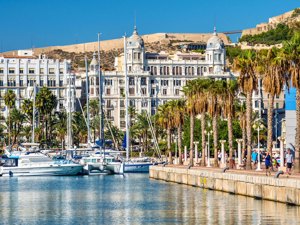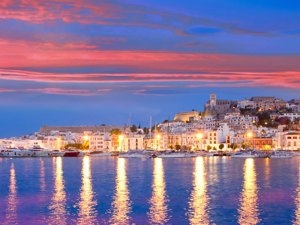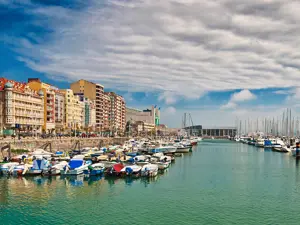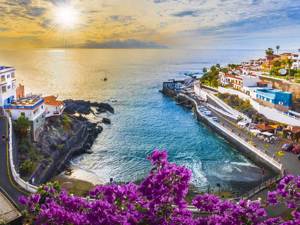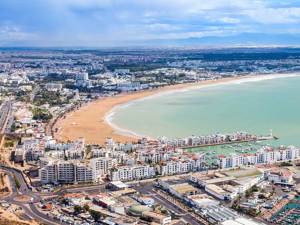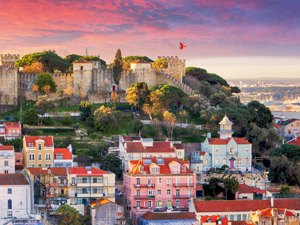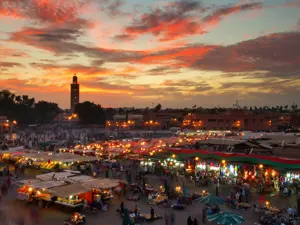The treasure of Andalusia
Granada, home of the Iberian Peninsula’s last Arabian kingdom, is one of the world’s most stunning cities, full of stories and legends, and gives its name to one of the eight provinces of Andalusia.

Photo: © Sisterscom.com, Shutterstock
Sitting on the Sabika hill, and separated from the Albayzin by the Rver Darro, the Alhambra (meaning “red castle” in Arabic) is the most prestigious and best known monument. The citadel, the buildings and the gardens are a UNESCO World Heritage Site, and are filled with symbolism and mythology. The Alhambra is reached from Plaza Nueva.
Alhambra

Photo: © Sisterscom.com, Shutterstock
The Cuesta de Gomérez, which leads up towards the Renaissance-style Puerta de las Grenadas. The climb arrives at the Plaza de los Aljibes, on the left of which lies the triangular-shaped Alcazaba citadel, which is surrounded by solid walls and is the oldest construction on the hill together with the Torres Bermejas. Here, the Torre de la Vela offers a stunning panorama of Granada. The Puerta del Vino gives access to the Palatine apartments. The façade of the Cuarto Dorado (golden room), where the sultan conducted meetings, is one of the Alhambra’s most beautiful. Ornately decorated and with a fountain in the centre, the façade has two doorways: the door on the right leads to the sultan’s private lodgings and on the left to the Patio de los Arravenes (patio of the myrtles), around which the rooms of the Palatio de Comares are arranged.

Palacio de los Leones. Photo: © Sisterscom.com, Shutterstock

Palace of Charles V. Photo: © Sisterscom.com, Shutterstock
The Palacio de los Leones, the private residence of monarchs, towering beside the Palacio de Comares, surrounds a patio that is supported by 124 slender columns. The Alhambra complex boasts places and monuments of great architectural interest: Saint Frances convent, the burial place of Queen Isabella the Catholic before her transfer to Granada’s royal chapel, and also resting place of her consort Ferdinand of Aragon, their daughter Joan the Mad and her husband Philip the Handsome; the Church of Santa Maria de la Alhambra, the city’s first cathedral, with gothic plan, which was erected on the ruins of the royal mosque; the Palace of Charles V, one of Spain’s most stunning Renaissance monuments, which was designed in 1527 and is now home to the Museum of the Alhambra.

L’Albayzín. Photo: © Sisterscom.com, Shutterstock
L’Albayzín
The Albayzin, dating back to the XI century, with its Medina and the main mosques. The Santa Ana church with mudéjar style tower and the Moorish greater chapel, is found in Plaza de Santa Ana. El Bañuelo, one of Spain’s oldest and best-preserved Arabian baths, is located alongside the remains of the Cadí Bridge, which united the Alhambra with the Albayzin quarter.

Sacromonte, Granada. Photo: © Sisterscom.com, Shutterstock
The districts of Granada
The Paseo de los Tristes is one of Granada’s most bustling and cosmopolitan areas, where a stunning view of the Alhambra can be admired. The Calle Peso de la Harina leads to the Sacromonte quarter with its characteristic cave-houses, which are partly carved out of the Valparaíso hill. On one of the high points of the city, the Albaicín quarter still manages to retain a strong Arab influence. Steep, narrow roads are home to the cármenes (houses with gardens) and ancient mosques upon which churches have been built.
The Mirador de San Nicolás

The Mirador de San Nicolás. Photo: © Sisterscom.com, Shutterstock
The mirador de San Nicolás is one of Granada’s most famous and popular squares, and provides a wonderful view of the Alhambra and, on clear days, as far as the main peaks of the Sierra Nevada. The Cathedral of Granada, situated behind the Gran Vía de Colón, was erected on the pillars of the main mosque. Inside Gothic, Baroque and Renaissance styles blend harmoniously, making it one of the most sumptuous Christian temples of southern Spain.
Andalusian cuisine
The Andalusian cuisine is made of fresh and local ingredients, with fish-based dishes from the coastal provinces or inland meat dishes and reflects its history, rich in aromas, flavors and colors. Famous are the cold soups such as the Andalusian gazpacho with vegetables and the ajoblanco (white garlic) with bread, crushed almonds, garlic, olive oil typical of the city of Granada and Malaga with fruit such as grapes or melon. The salmorejo is instead a typical soup of Cordova and also known in Seville prepared with tomato, garlic, hard bread and served with on top slices of boiled egg, pieces of jamón serrano and a drizzle of olive oil. To taste in Andalusia there are also wines like Málaga and sherry.

Gazpacho andaluso. Photo: © Sisterscom.com, Shutterstock

Ajoblanco. Photo: © Sisterscom.com, Shutterstock

Salmorejo. Photo: © Sisterscom.com, Shutterstock
The Costa Tropical of Granada
The Costa Tropical, the coastal area of Granada province, extends for 103 km and is dotted with beaches and bays with crystal-clear waters of the Mediterranean Sea. Thanks to its subtropical microclimate, it enjoys 320 days of sun a year and the annual average temperature exceeds twenty degrees, making it possible to swim all year round.

The Costa Tropical of Granada province. Photo: © Sisterscom.com, Shutterstock
Text by Eugenio Sorrentino
Updated by Alisè Vitri
Avion Tourism Magazine
Photos: © Sisterscom.com, Shutterstock
Photos: © Sisterscom.com, Shutterstock
Copyright © Sisterscom.com
Video: www.granadatur.com
Tourism Boards
www.granadatur.com
www.andalucia.org
www.andalucia.org
Partnership with Booking.com
Where to sleep in Granada

Photo: © Sisterscom.com, Shutterstock
Granada is a welcoming city and offers different possibilities for accommodation.
To find the ideal hotel and the best offers you can do a search for the stars but also for districts or landmarks.
STARS
Hotels for stars, differentiated by type of services:
AIRPORT
Hotels near the airports
HOTELS NEARBY
WHERE TO GO in granada
Monuments of Granada

Photo: © Sisterscom.com, Shutterstock
L'ALHAMBRA
A wonderful complex of buildings and gardens, which was the political and aristocratic centre of western Muslims. The boundary of the palace is made up of rectangular court yards of great beauty, adorned by numerous fountains and buildings in Nazari Dynasty style which served as a residence to the kings and their servants.

Photo: © Sisterscom.com, Shutterstock
GENERALIFE
This was the country home of the Sultan, the vegetable gardens to supply the palaces and a place of recreation for the nobility. The lush vegetation was achieved by diverting the course of the Darro river, via canals, to Generalife. The patio of the Acequia (canal) is of great beauty and colour, and gives access to the palace. From here you can admire views of extraordinary beauty. The opening hours are the same as those of the Alhambra.

Photo: © Sisterscom.com, Shutterstock
GRANADA CATHEDRAL
Diego de Siloé found the perfect way of combining a Renaissance dome with a Gothic floor plan. He joined the circular and basilica ground plans, which earned him the recognition of his fellow architects at that time. The main chapel encapsulates the greatness of this building. The dome of the main chapel is decorated with beautiful stained glass, sculptures and paintings by Alonso Cano. Currently the old Chapter house houses the treasures of the cathedral.

Photo: © Sisterscom.com, Shutterstock
CARTUJA MONASTERY
Although the original plans dates back to the Middle Ages, the style is completely Baroque.
It was not ultimately built until 1515, and thus the Cartuja moved further from its initial concept of austerity to incorporate the work of a variety of artists into the church, sacristy and sacrarium. These artists include Bocanegra and Sánchez Cotán. The jewelled inlays are of particular note.
It was not ultimately built until 1515, and thus the Cartuja moved further from its initial concept of austerity to incorporate the work of a variety of artists into the church, sacristy and sacrarium. These artists include Bocanegra and Sánchez Cotán. The jewelled inlays are of particular note.

Photo: © Sisterscom.com, Shutterstock
ROYAL CHAPEL
Situated inside the cathedral, the Royal Chapel was constructed in Gothic style even though Renaissance style building had been used for some time in Castile.

Photo: © Sisterscom.com, Shutterstock
EL BANUELO
Built in the 11th century, these are the most important, oldest and best preserved Arab baths in Spain and one of the oldest constructions in Muslim Granada. With rectangular floor plan, the baths feature overlapping columns and Roman, Visigothic and caliphate capitals, and vaults pierced with star shaped skylights.
Museum of Granada
Granada Science Park
The Science Park is an interactive museum where visitors are invited to actively take part for a better understanding of the phenomena that surround them. It is a place designed for experimentation, encouraging the desire to learn and helping us understand the world we live in.
www.parqueciencias.com
www.parqueciencias.com
Excursions in Granada and its surroundings
Partnership with GetYourGuide
Shopping
You might be interested in
Destinations found in the vicinity
Other destinations
Airports nearby Granada






